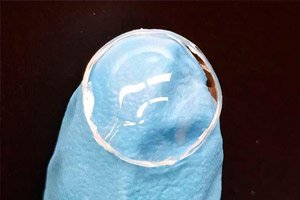
All iLive content is medically reviewed or fact checked to ensure as much factual accuracy as possible.
We have strict sourcing guidelines and only link to reputable media sites, academic research institutions and, whenever possible, medically peer reviewed studies. Note that the numbers in parentheses ([1], [2], etc.) are clickable links to these studies.
If you feel that any of our content is inaccurate, out-of-date, or otherwise questionable, please select it and press Ctrl + Enter.
3D printed hydrogel enables continuous drug delivery through contact lenses
Last reviewed: 03.07.2025
 ">
">The next time you need to take a prescription medication, it may be as easy as putting in a contact lens, thanks to a new discovery by researchers at the University of Waterloo.
A team of scientists from the Department of Chemistry and the School of Optometry and Vision Sciences at the University of Waterloo have created a new type of hydrogel that can deliver drugs to patients with a variety of eye conditions when 3D printed onto a contact lens.
The paper, titled "Injectable and 3D Extrusion Printable Hydrophilic Silicone-Based Hydrogels for Controlled Ocular Delivery of Ophthalmic Drugs," was published in the journal ACS Applied Bio Materials.
This hydrogel, which is a gel capable of retaining a significant amount of water, is silicone-based and allows you to control the amount of medication needed, ensuring its continuous release throughout the entire time you wear the contact lens.
Using drug-loaded contact lenses can help doctors reduce pain and reduce the frequency of drug administration because the drug will be delivered during normal lens wear.
Although silicone is difficult to 3D print, the new hydrogel has unique properties. It uses a special type of silicone that easily attracts water and cures with ultraviolet light. Once cured, the gel remains flexible and strong enough to retain its shape after being stretched and compressed.
"Once we were confident that the hydrogel was strong and flexible enough, we decided to test its ability to retain and release drugs using amoxicillin, a commonly prescribed antibiotic for treating eye diseases," said Professor Shirley Tan, in the Department of Chemistry and dean of research in the Faculty of Science at the University of Waterloo.
The researchers found that the hydrogel's macroporous structure helped regulate the release of amoxicillin over time during laboratory tests. They also found that the hydrogel could be injected or extrusion printed, making it easier to apply to contact lenses.
"This concept is much more effective and convenient for patients than using eye drops, which are often difficult to apply and require multiple applications throughout the day," added Professor Lyndon Jones, from the School of Optometry and Vision Sciences and director of the Centre for Ophthalmic Research and Education.
The team also tested the stability of the hydrogel material during storage and found that the drug encapsulation remained effective for a month.
"After encapsulation in a gel and storage for a month, amoxicillin remained virtually unchanged," said Sayan Ganguly, a postdoctoral fellow in the Department of Chemistry. "Our results show that this hydrogel is safe for human eyes and can be effectively used in various medical applications."
With a newly filed patent application, researchers aim to expand the use of contact lenses to treat eye diseases.
